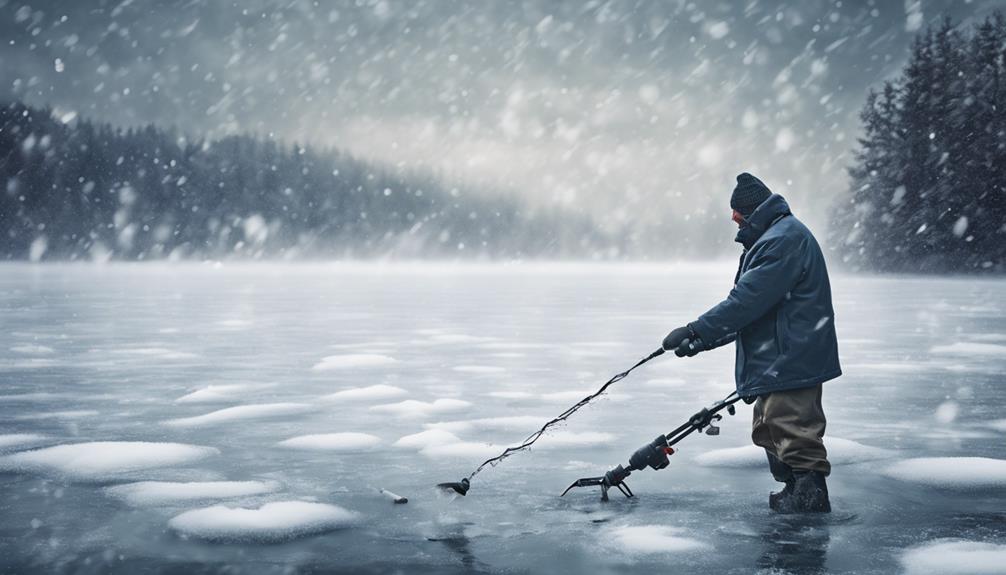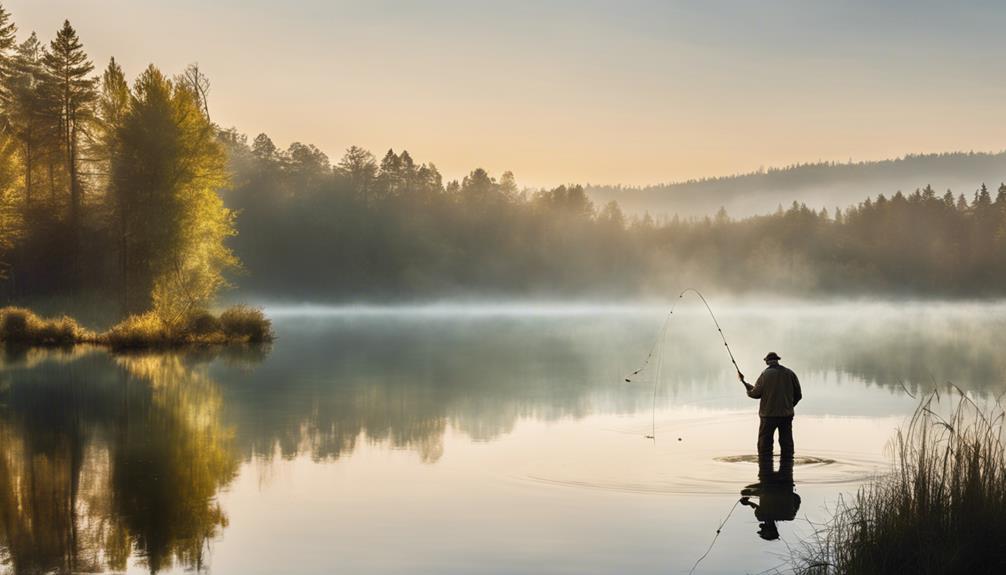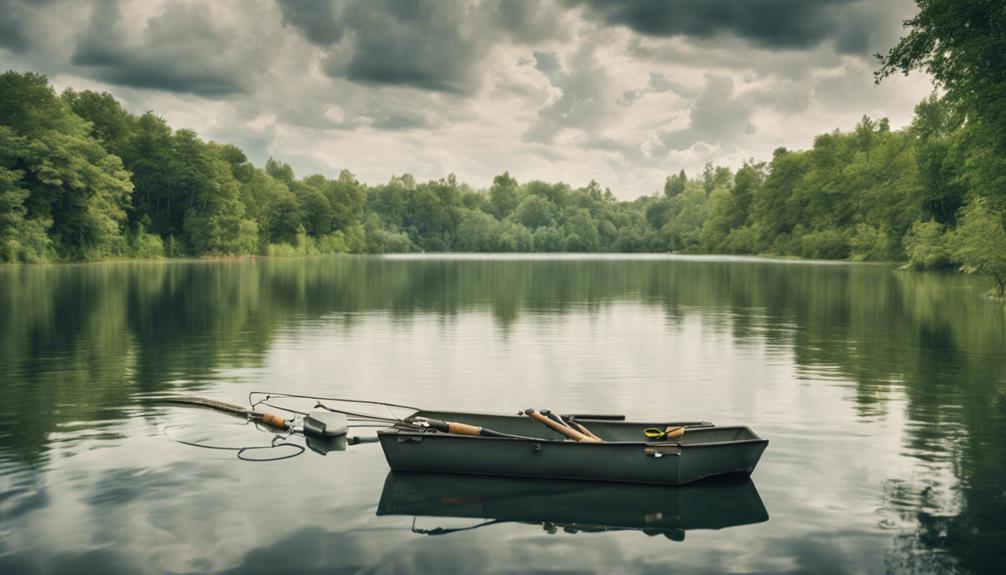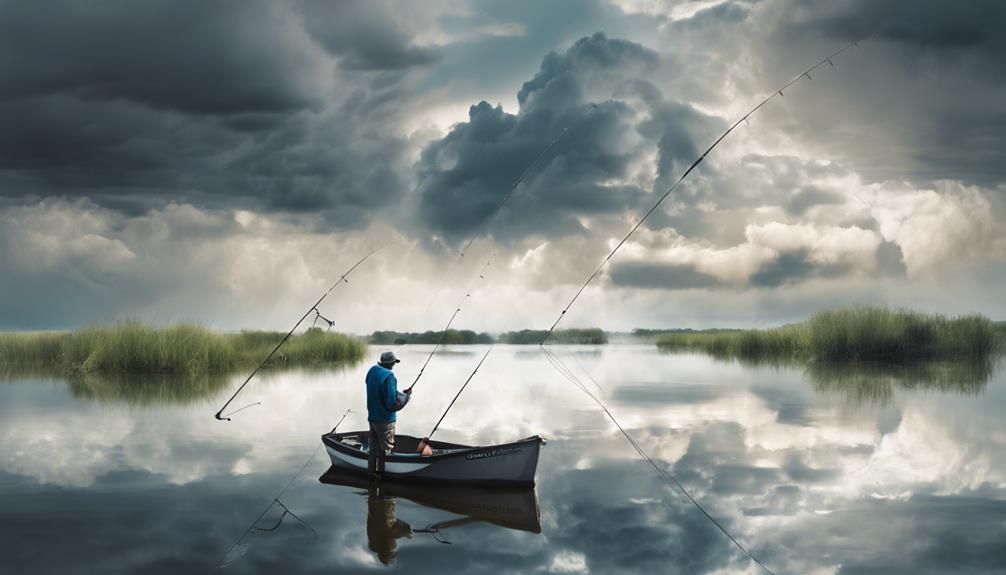Temperature significantly impacts fishing conditions by influencing fish metabolism and behavior. Different fish species have preferred temperature ranges where they are most active. For example, trout thrive in cooler waters around 50°F to 60°F, while bass are more active in temperatures between 65°F to 75°F. Water temperature fluctuations can alter fish movement, affecting angling success. Understanding how temperature affects fish behavior is crucial for adapting fishing techniques effectively and increasing your chances of a successful catch. By considering these temperature factors, anglers can strategically enhance their fishing experiences.
Optimal Temperature Ranges for Fishing
When fishing, it's crucial to be aware of the optimal temperature ranges for different fish species to maximize your chances of success. Temperature fluctuations play a significant role in determining fishing success as they directly impact the behavior and feeding patterns of various fish species. Understanding the temperature preferences of different fish species is essential for choosing the right fishing location and time.
Different fish species have specific temperature ranges in which they're most active and likely to feed. For example, trout are known to prefer cooler waters with temperatures ranging from 50°F to 60°F, while bass are more active in warmer waters between 65°F to 75°F. These temperature preferences are influenced by the metabolic rate of the fish, which in turn affects their feeding behavior.
Temperature fluctuations can trigger changes in fish behavior. Sudden drops or rises in water temperature can cause fish to become less active and retreat to deeper or shallower waters, depending on the species. During temperature fluctuations, it's essential to adjust your fishing techniques accordingly to increase your chances of success. By monitoring water temperatures and understanding the optimal temperature ranges for different fish species, you can strategically plan your fishing trips and improve your overall catch rate.
Impact of Water Temperature on Fish
Water temperature significantly influences the physiological responses and behavior of fish species. Understanding the impact of water temperature on fish can greatly improve your fishing success. Here are three key points to consider:
- Temperature fluctuations directly affect fish activity: Fish are ectothermic animals, meaning their body temperature is regulated by the temperature of the surrounding water. As water temperature changes, so does the metabolic rate of fish. Warmer water temperatures generally increase fish metabolism, leading to higher activity levels and a greater need for food. Conversely, colder water temperatures can slow down fish metabolism, causing them to be less active and feed less frequently.
- Water temperature is crucial for fishing success: Different fish species have specific temperature preferences based on their biological needs. Knowing the preferred temperature range of the fish you're targeting can significantly increase your chances of a successful catch. For instance, cold-water species like trout thrive in cooler temperatures, while warm-water species such as bass prefer warmer waters. By understanding these preferences, you can strategically plan your fishing trips to coincide with optimal water temperatures for your target species.
- Temperature gradients in water bodies: Water bodies aren't uniformly heated, creating temperature variations at different depths and locations. Fish often move within the water column to find their preferred temperature zones. During colder months, fish may seek out warmer pockets of water, such as shallow areas exposed to sunlight or near underwater structures that trap heat. In contrast, during hot summer days, fish may retreat to deeper, cooler waters to avoid overheating. Understanding these temperature gradients can help you locate fish more effectively and improve your fishing results.
Seasonal Temperature Changes and Fishing
Seasonal temperature fluctuations play a crucial role in shaping fishing conditions and influencing the behavior of fish species in aquatic environments. During the winter months, when temperatures drop significantly, bodies of water freeze over, creating opportunities for ice fishing. This unique form of fishing involves cutting a hole in the ice and dropping a line to catch fish that are active in cold water, such as trout and walleye. These fish species tend to move slower in the cold, requiring anglers to adjust their techniques accordingly.
In contrast, summer brings warmer temperatures that heat up the water, leading to increased activity among fish like bass. Summer bass fishing often involves targeting these aggressive predators in shallow waters near structures like docks or vegetation. As the temperature rises, bass become more active and are more likely to chase bait and lures. Anglers can capitalize on this behavior by using topwater lures or diving crankbaits to entice strikes from bass during the summer months.
Understanding the impact of seasonal temperature changes on fish behavior is essential for successful fishing trips. Whether you're braving the cold for some ice fishing action or enjoying the warmth of summer bass fishing, adapting your tactics to match the temperature conditions can significantly improve your chances of landing a great catch.
Warm Vs. Cold Water Fishing Tactics
The contrasting temperatures of water bodies significantly impact fishing tactics, requiring adjustments to optimize your angling success in different conditions. When it comes to warm vs. cold water fishing tactics, understanding the nuances can make a substantial difference in your catch rates.
Here are three key points to consider:
- Warm Water Techniques: In warmer water, fish tend to be more active and can be found in shallower areas. Topwater lures and faster retrieval speeds are often more effective in these conditions. Target areas with vegetation and structure where fish seek shelter from the heat. Additionally, using bright and flashy lures can attract fish's attention in warmer waters.
- Ice Fishing Strategies: Cold water fishing, particularly ice fishing, requires a different approach. During colder months, fish metabolism slows down, and they're more lethargic. Therefore, using smaller and slower-moving baits like jigs tipped with bait can be more successful. It's essential to drill multiple holes and move around to find where the fish are congregating under the ice.
- Temperature Fluctuations and Fishing Patterns: Pay attention to temperature fluctuations as they can impact fish behavior. In warm water, fish may move to deeper, cooler areas during hot days. Conversely, in cold water, a sudden warm spell can trigger increased activity. Monitoring water temperatures and adjusting your tactics accordingly can help you stay ahead of changing fishing patterns.
Temperature's Influence on Fish Behavior
Temperature fluctuations play a crucial role in shaping fish behavior and activity levels, influencing their feeding patterns and movement within aquatic environments. Fish are ectothermic, meaning their internal body temperature reflects that of their surroundings. As such, changes in water temperature can directly impact their metabolism, energy levels, and overall behavior.
Fish activity is closely tied to temperature gradients in water bodies. Warmer water temperatures generally lead to increased metabolic rates and higher activity levels in fish species like bass and catfish. This heightened activity often results in more aggressive feeding habits as fish seek out food sources to meet their increased energy demands. In contrast, colder water temperatures can cause fish to become less active, leading to reduced feeding behavior as their metabolism slows down.
Temperature also influences fish movement within bodies of water. Fish tend to migrate towards areas with more favorable temperature conditions. For example, during colder months, fish may move to deeper waters where temperatures are more stable. Understanding these temperature-driven movement patterns can help anglers locate fish more effectively, increasing their chances of a successful catch.
Monitoring Weather Patterns for Fishing Success
To enhance your fishing success, it's essential to monitor and analyze weather patterns diligently. Weather forecasting and temperature tracking are crucial elements that can significantly impact your fishing experience. Here are three key aspects to consider when monitoring weather patterns for fishing success:
- Weather Forecasting Accuracy: Utilize reliable weather forecasting sources to stay informed about upcoming weather conditions. Understanding factors like wind speed, precipitation, and atmospheric pressure can help you anticipate changes in fish behavior. For example, a sudden drop in barometric pressure often indicates active feeding times for fish, making it an ideal opportunity for fishing.
- Temperature Fluctuations: Keep a close eye on temperature trends in your fishing area. Fish are cold-blooded creatures, meaning their activity levels are influenced by water temperature. Warmer water temperatures generally lead to increased fish activity, while colder temperatures may cause fish to be less active. By tracking temperature patterns, you can adjust your fishing techniques accordingly to maximize your chances of a successful catch.
- Weather Patterns Impact on Fish Behavior: Different weather conditions can affect fish behavior in various ways. For instance, sunny days may drive fish to deeper waters for shade, while overcast skies could encourage them to move closer to the surface. By understanding how weather patterns influence fish behavior, you can adapt your fishing strategies to align with the prevailing conditions and improve your overall fishing success.
Adjusting Techniques in Extreme Temperatures

How can extreme temperature conditions impact fish behavior and necessitate adjustments in fishing techniques for optimal results?
In extreme cold temperatures, ice fishing strategies become essential for success. Fish tend to move slower in colder waters, so using smaller and more natural-looking baits, such as tiny jigs or live bait, can be effective. Additionally, drilling multiple holes and frequently changing locations can help increase your chances of catching fish. Adapting to the cold by dressing warmly and using insulated shelters can also make the fishing experience more comfortable and productive.
Conversely, in hot weather, fishing gear adjustments are crucial. Fish are more active in warmer temperatures, so using faster retrieval speeds and brighter, flashier lures can attract their attention. It's also important to fish deeper in hot weather, as fish tend to seek cooler waters. Adjusting the time of day you fish can also be beneficial, as early mornings and evenings are generally cooler and better for fishing.
In both extreme cold and hot temperatures, being prepared and making the necessary adjustments to your fishing techniques can significantly improve your chances of success. By understanding how fish behavior changes with temperature fluctuations and tailoring your approach accordingly, you can adapt to any weather conditions and continue enjoying a successful fishing experience.
Temperature Tips for Different Fish Species
Understanding the preferred temperature ranges for different fish species is crucial for optimizing your fishing success. Fish have species-specific preferences when it comes to water temperature, and being aware of these can significantly enhance your chances of a successful fishing trip.
Here are some temperature tips for different fish species:
- Species Specific Preferences:
Different fish species have specific temperature preferences based on their biological needs. For example, trout are known to thrive in cooler waters with temperatures ranging between 50-60°F, while bass prefer slightly warmer waters around 65-75°F. Understanding these preferences can help you target specific species more effectively.
- Temperature Fluctuations:
It's essential to consider how temperature fluctuations can impact fish behavior. Sudden drops or rises in water temperature can influence fish activity levels. For instance, cold-blooded fish like catfish may become less active in colder waters, requiring a different approach compared to warm-water species. Monitoring temperature changes can give you valuable insights into when and where to fish.
- Adaptation Strategies:
To adapt to temperature variations, consider using techniques like adjusting the depth of your bait or lure presentation. In colder waters, fishing deeper where temperatures are more stable can attract cold-water species. Conversely, in warmer waters, focusing on shallower areas may yield better results with species that prefer higher temperatures. Flexibility and adapting to temperature fluctuations are key to successful fishing across different fish species.
Frequently Asked Questions
How Does Temperature Affect Fishing Line Strength?
When it comes to fishing line strength, temperature can significantly impact its performance. Changes in temperature can alter the line's sensitivity, making it more prone to breaking or weakening under certain conditions. Understanding how temperature affects line sensitivity is crucial for adjusting your fishing techniques accordingly.
Keep in mind that variations in temperature can directly influence the overall strength and durability of your fishing line while out on the water.
Can Temperature Changes Impact Bait Effectiveness?
When temperature shifts, bait behavior can be significantly influenced. Changes in water temperature can impact the activity levels and movements of baitfish, affecting their visibility and appeal to predatory fish.
As a result, catch rates may fluctuate based on how the bait responds to varying temperatures. Understanding these dynamics can help anglers adjust their fishing strategies to optimize bait effectiveness and improve their chances of a successful catch.
What Role Does Temperature Play in Fish Migration Patterns?
When it comes to fish migration patterns, temperature plays a crucial role. Water currents influence the movement of fish populations, with temperature acting as a key factor in determining their routes.
Changes in temperature can impact spawning behavior, leading to shifts in habitat and migration patterns. Climate change, with its warming effects on water bodies, can significantly alter these dynamics, influencing the distribution and behavior of various fish species.
Does Temperature Affect the Timing of Fish Feeding?
When it comes to fish behavior, temperature can indeed affect the timing of feeding patterns.
Warmer waters tend to increase fish metabolism, leading to more active feeding behavior.
Conversely, colder temperatures can slow down fish metabolism, resulting in reduced feeding activity.
Understanding how temperature influences fish feeding patterns is crucial for anglers looking to optimize their fishing experience and increase their chances of a successful catch.
How Does Temperature Impact the Oxygen Levels in Water?
Water quality is crucial for aquatic life, impacted by temperature. As temperatures rise, oxygen levels in water decrease due to reduced solubility. This can lead to oxygen-deprived conditions, harming fish and other aquatic organisms. Cooler temperatures generally hold more dissolved oxygen, supporting healthier ecosystems.
Understanding how temperature affects oxygen levels is vital for preserving aquatic habitats and the diverse life they sustain.
Conclusion
In conclusion, temperature plays a crucial role in fishing conditions as it directly affects the behavior and activity of fish. Understanding the optimal temperature ranges for different species, monitoring seasonal changes, and adjusting tactics accordingly can significantly improve your fishing success.
By paying attention to temperature variations and weather patterns, you can adapt your techniques to maximize your chances of a successful fishing outing. Remember, temperature is a key factor in determining the success of your fishing expedition.



